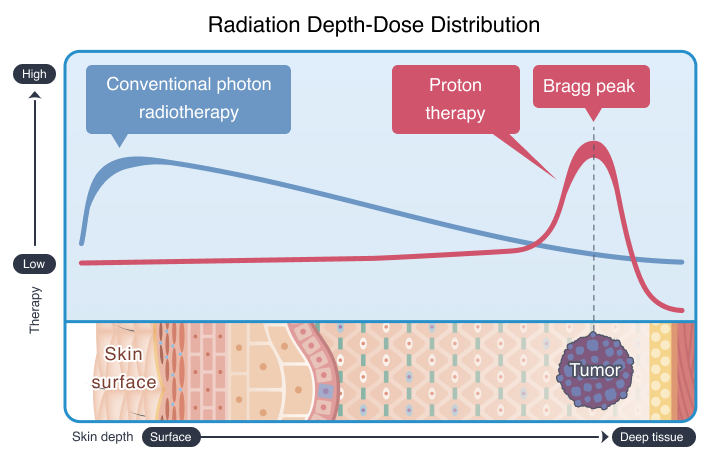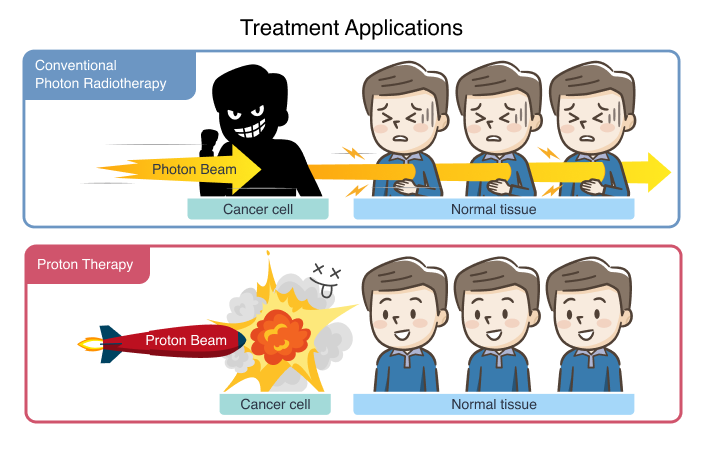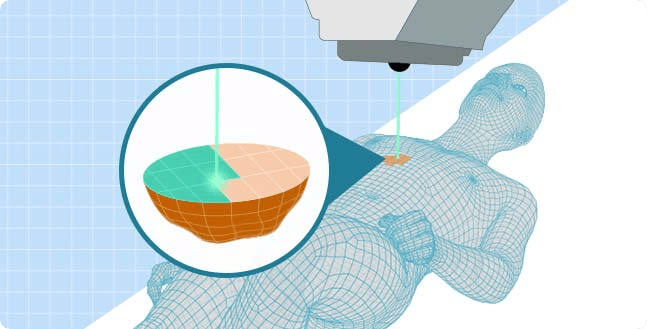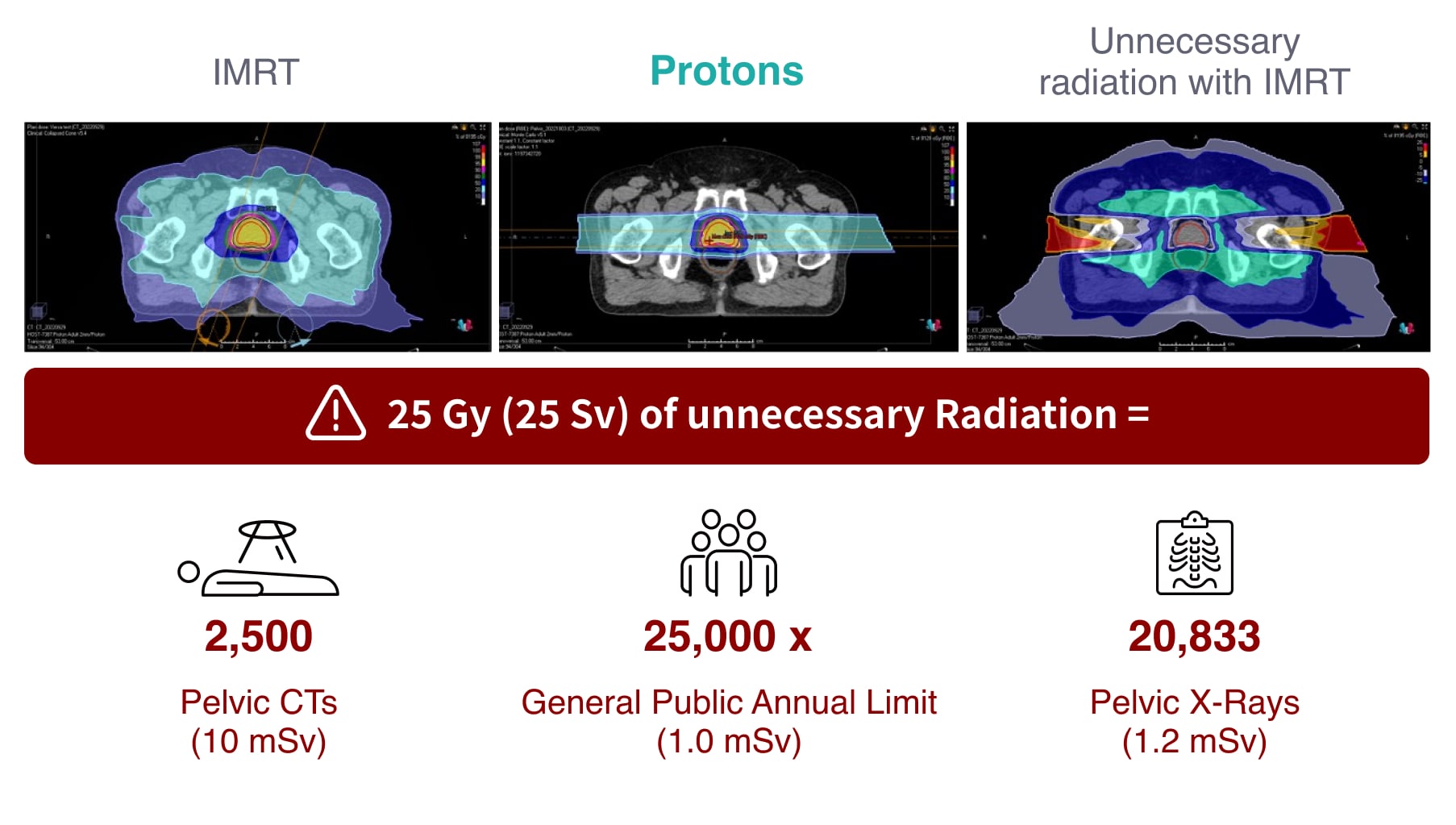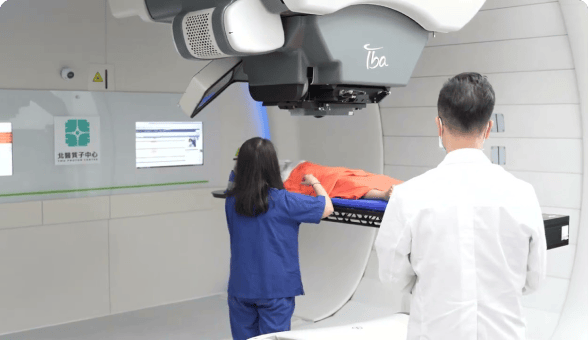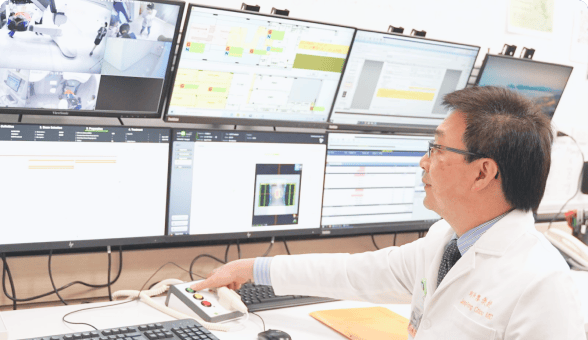
What is Proton Therapy?
A New Generation of Cancer Treatment with High Precision
Proton therapy is an advanced type of radiation therapy known for its high accuracy. Unlike traditional radiation therapy, which uses X-rays (photons), proton therapy uses beams of protons to precisely target and treat cancer cells. By adjusting the radiation dose according to the tumor’s exact location and shape, proton therapy focuses radiation directly on the tumor. This ensures cancer cells are effectively eliminated.A major advantage of proton therapy is the Bragg peak effect, where proton beams deliver their highest energy precisely at the tumor site. Once the proton beam reaches the tumor, its energy quickly decreases, greatly reducing damage to healthy tissue beyond the tumor.Proton therapy’s precise targeting allows for maximum destruction of cancer cells while significantly protecting nearby healthy tissue. This makes it one of today’s most advanced and effective cancer treatment methods.
Three Key Advantages of Proton Therapy
Cancer treatment has entered a new era
Proton therapy is transforming cancer care,
offering new hope and a better quality of life for patients.
offering new hope and a better quality of life for patients.
Proton therapy is transforming cancer care, offering new hope and a better quality of life for patients.
01
Remarkable Precision
Tumor Targeting
Proton therapy precisely targets tumors using advanced techniques such as pencil-beam scanning (PBS) and 3D image-guided navigation. This technology accurately determines the tumor’s size, shape, and depth, providing highly targeted treatment.
- Precisely shapes radiation to match the tumor
- Can treat multiple tumors in the same area simultaneously
- Effective against cancers difficult to treat with traditional radiation, such as liver, eye, skull base, and pediatric tumors
At TMU Proton Center, we utilize state-of-the-art proton therapy technologies, including pencil-beam scanning, 3D cone-beam CT imaging, and respiratory motion management, to enhance treatment accuracy and effectiveness.
02
Fewer Side Effects and Better Organ Protection
Most Patients Can Maintain Their Daily Life
- Significantly reduces radiation exposure to nearby healthy organs
- Painless treatment without burns or discomfort
- Lowers the risk of radiation-induced secondary cancers
- Allows safe re-treatment of previously irradiated areas, as determined by doctors
- No radiation remains in the body afterward—patients can safely be around others
Beyond technology, TMU Proton Center, in collaboration with Taipei Cancer Center, provides comprehensive patient-centered care, offering supportive services to ensure patients feel secure and cared for during their treatment.
03
Shorter Treatment Times for Certain Cancers
Effective Treatment That Protects Quality of Life
- Higher radiation doses for certain cancers, leading to shorter treatment durations and improved outcomes
- Enhances local tumor control while protecting organ function
- Versatile treatment suitable for standard long-course therapy, short-course therapy, and precise hypofractionated stereotactic radiation therapy (SBRT)
With its wide-ranging applications, proton therapy offers an effective treatment solution for many cancer types.
Photon Radiotherapy Works,
but Proton Therapy Works Even Better
Proton therapy significantly reduces side effects on healthy tissues, lowering the risk of post-treatment complications. This makes the treatment process smoother, safer, and easier for patients to tolerate and adapt to the whole treatment course.
Comparison of Radiation Therapy Types
Swipe right to see more
| Conventional Radiation Therapy | Particle Radiation Therapy | ||
|---|---|---|---|
| Photon | Proton | Heavy Ion | |
| Physical effect (Bragg Peak Effect) | |||
| Biological Effectiveness (Compared to Photon) | 1x | 1.1x | 2-3x |
| Indications | Standard indications | Expanding to cover standard indications | Mainly used for tumors resistant to conventional radiation therapy |
| Treatment Duration | Typically 5-7 weeks | Similar to or slightly shorter than conventional therapy | Shorter than conventional therapy (usually within 4 weeks) |
| Cost | Mostly covered by insurance | Self-pay | Self-pay |
| Advantages | Widely available with comprehensive equipment | Reduces side effects | Effective for radiation-resistant tumors |
The Expanding Uses of Proton Therapy in Cancer Treatment
From Common Cases to Complex Challenges
At TMU Proton Center, our experienced physicians create customized cancer treatment plans tailored to each patient's unique health condition and needs.
Proton therapy is an advanced form of radiation treatment compared to traditional radiation methods. With ongoing technological advancements and growing availability, proton therapy’s use in cancer treatment is rapidly expanding.
Proton therapy effectively treats all cancers typically handled by traditional radiation. It is particularly beneficial for cancers that are difficult to treat, including liver cancer, eye tumors, skull base tumors, and childhood cancers.
Proton therapy can be applied as a standalone treatment or combined with chemotherapy, targeted therapy, or immunotherapy. Due to its reduced side effects, proton therapy can also lessen overall treatment-related side effects when used alongside other treatments.
Proton therapy effectively treats all cancers typically handled by traditional radiation. It is particularly beneficial for cancers that are difficult to treat, including liver cancer, eye tumors, skull base tumors, and childhood cancers.
Proton therapy can be applied as a standalone treatment or combined with chemotherapy, targeted therapy, or immunotherapy. Due to its reduced side effects, proton therapy can also lessen overall treatment-related side effects when used alongside other treatments.

Neurological Tumors
Proton therapy is increasingly being used in the treatment of neurological diseases. It plays a key role in treating brain tumors, especially those located near critical nerve structures, helping to minimize damage to surrounding healthy brain tissue while effectively targeting the tumor.
Ophthalmic Tumors
In ophthalmology, proton therapy is primarily used for eye tumors such as retinoblastoma. Given the delicate nature of eye structures, proton therapy offers highly precise tumor targeting, reducing the risk of damage to vision and other essential eye functions.
Other Medical Applications
Proton therapy is also being explored in other medical fields, including immune disorders, palliative pain management, and lung diseases. By reducing radiation exposure to healthy tissues, proton therapy opens new possibilities for treating various chronic and complex conditions.


Cases Treated at TMU Proton Center
At TMU Proton Center, proton therapy has successfully treated patients of all ages, proving its effectiveness even in the youngest and most delicate cases.
什麼是質子治療
三大優勢
放射治療比一比
特殊案例
Online Appointment
We warmly invite you to schedule an online consultation. Our dedicated team will reach out to you promptly.
GET IN TOUCH.

